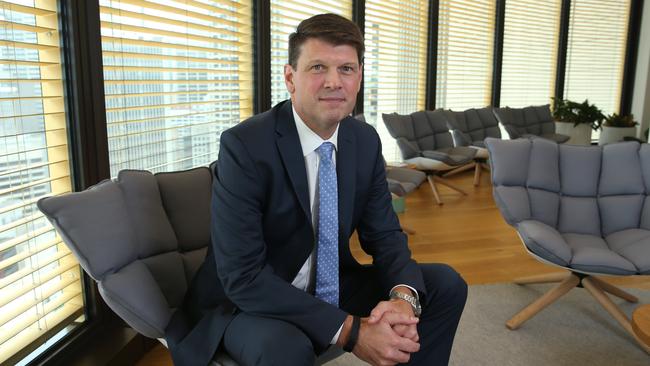AGL plunges to $2.28bn loss, eyes business model changes
Speculation is growing the power group may split its retail and generation arms, after plunging to a $2.28bn half-year loss.

AGL Energy is reassessing its entire business model as a solar-sparked price rout and government intervention put the brakes on earnings growth, sparking speculation the power giant may split its retail and generation arms and accelerate a shift into new sectors including telecommunications.
Australia’s largest electricity retailer plunged to a $2.28bn statutory loss for the first half after it was hit by a shock $2.7bn writedown driven by unprofitable wind farm deals. Underlying profit fell 27 per cent to $317m for the six months to the end of December from $432m, in line with consensus forecasts. Costs will be cut over the next two years to reflect more challenging conditions.
The utility is being battered by a storm of low wholesale electricity prices as cheap renewables continue to flood onto the market, while moves by both state and federal governments to underwrite new generation have also contributed to a tough outlook for the company.
Analysts questioned whether AGL may even look at a split of its retail and generation arms to reflect the loss of value from operating as an integrated retailer.
“Our retail business has a clearer path towards a future state in which it provides customers’ access to essential energy, data, electric vehicle, battery and other services on a carbon neutral basis,” chief executive Brett Redman said. “And we are seeing the value of that retail service become more independent from the value we derive from our large-scale centralised energy supply portfolio.”
Asked if that meant AGL was considering breaking up the retail side of the business from its generation portfolio, Mr Redman said there were no “black and white” answers, with more details to be announced at its investor day in March.
“Rather than rush it, we wanted to signal today that we are not sitting on our hands with our eyes shut and our ears closed to conditions around us. But at the same time we want to be thoughtful and come back with a complex answer to a complex situation at the end of March.”
AGL has launched a mobile phone division as it seeks to broaden revenue sources amid a crunch on its mainstay electricity business. The move comes some 18 months after Mr Redman walked away from a $3bn takeover of telco Vocus now in the crosshairs of a higher bid from Macquarie Infrastructure and Real Assets.
Still, the AGL boss denied he was now under extra time pressure to diversify its business model given a step-up in earnings pressures.
“We still have plenty of time,” Mr Redman told The Australian. “But the impairment last week was a good signal the pace of change in the market has accelerated from what we were seeing three to six months ago. So now we’re saying we need to pick up the pace in what we’re doing.”
Sales declined 14 per cent to $5.41bn, while earnings for its key wholesale markets business fell to $1.19bn from $1.29bn previously.
RBC analyst James Nevin said: “We still think it looks difficult to identify a turnaround yet for AGL with earnings headwinds over the next few years.”
AGL is also being forced to rethink how it runs coal plants, as earnings margins get squeezed during daytime hours by cheap solar.
The difference between the cost of coal production and the price it receives for electricity has fallen to less than $20 per megawatt hour, piling pressure on big generators including AGL to consider lowering their output or changing bidding patterns into the grid.
“We have to lower our operating costs furthermore. And at the end of the day we have also to rethink how we run all the units, in particular over the day when the prices are negative,” AGL chief operating officer Markus Brokhof told analysts on its interim results call. “That‘s something which we have to look at carefully and not to anymore lose money during the day.”
A flood of solar often pushes spot prices to low or even negative levels during the day, creating a headache for coal plants, which traditionally pump out power around the clock rather than switching on and off to meet market demand.
AGL reaffirmed full-year guidance of $500m-$580m and issued guidance for 2021 underlying earnings of between $1.585bn and $1.845bn, compared with consensus of $1.756bn.
It’s also targeting $150m of cost cuts by the 2022 financial year and said programs are underway to deliver a $100m reduction in sustaining capital expenditure by the 2023 financial year.
The Sydney-based company declared a dividend of 41c per share for the first half, down 6c on the previous period last year.
Average electricity spot prices have halved from a year ago to a range between $40 and $45 MwH in most states, as a flood of cheap renewables lowered daytime prices, along with cheaper gas and coal and softer demand amid COVID-19.
That’s hurt the bottom line of big utilities including AGL, who see little let-up in sight as the march of new large scale solar and wind generation contributes to cheaper wholesale prices.
AGL in January joined the big battery rush after agreeing deals with suppliers to provide up to 1000 megawatts of grid-scale storage.
It’s increasingly shifting its investment focus to clean energy despite owning some of the nation’s largest coal plants in Liddell and Bayswater in NSW’s Hunter Valley and Loy Yang A in Victoria’s Latrobe Valley.
It has laid out a 850MW battery storage target by 2024 including plans to build a 250MW battery at South Australia’s Torrens Island to back up the state’s wind and solar supplies.
AGL shares rose 1.25 per cent on Thursday to $11.30.


To join the conversation, please log in. Don't have an account? Register
Join the conversation, you are commenting as Logout